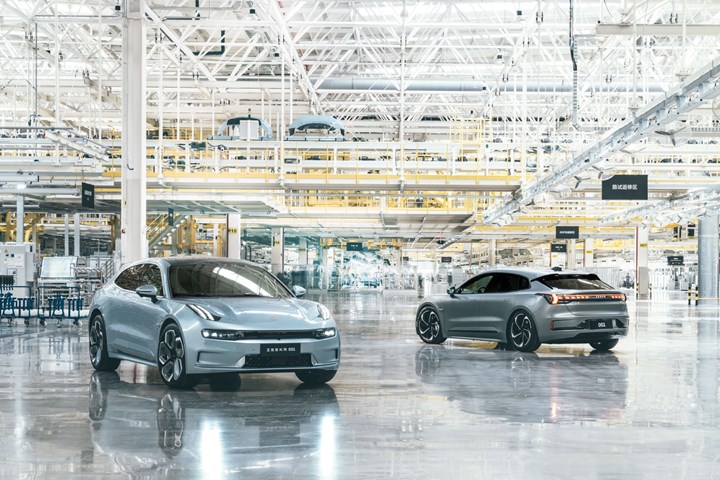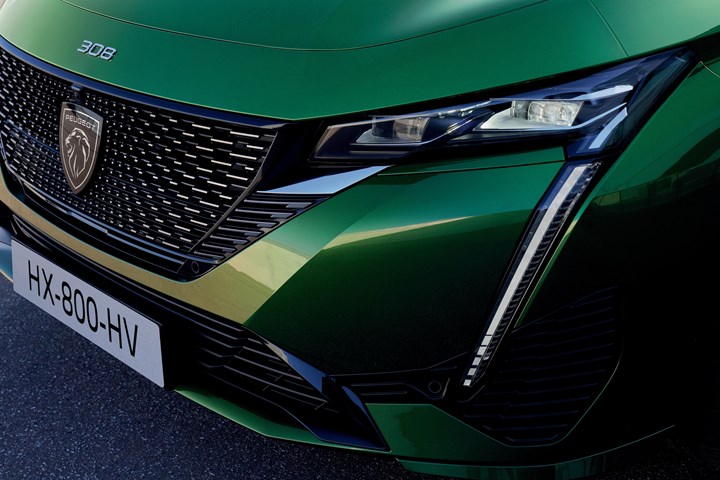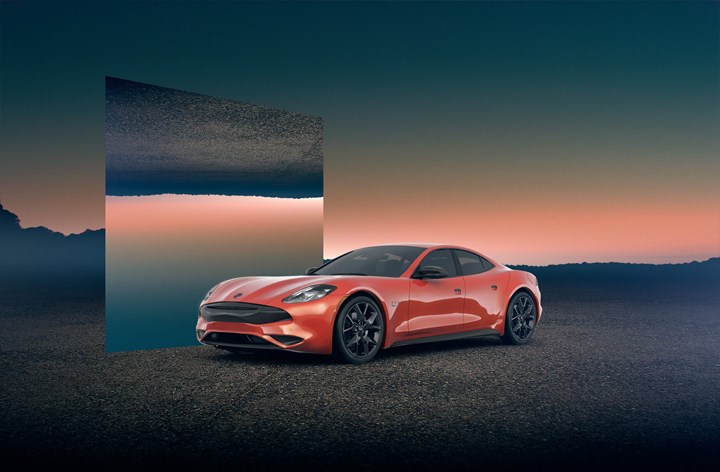On Zeekr, the Price of EVs, and Lighting Design
About Zeekr, failure, the price of EVs, lighting design, and the exceedingly attractive Karma
This week On Automotive
- A Chinese EV Company to Pay Attention To
- The EV Price Issue
- On Failure
- Learning About Lighting
- 2021 Karma GS-6L
///
A Chinese EV Company to Pay Attention To

The Zeekr 001 in the factory where it is built. The facility has a 300,000-annual capacity when operating at peak efficiency (e.g., executing a 180-second die change: When companies think about die changing time, you know they are serious about manufacturing.). (Image: Zeekr)
Zeekr.
The name sounds like a character in a video game or the tag of a graffiti artist.
Yet the reality of the name of the brand under the umbrella of Geely Holding Group is actually even more surprising:
According to the company, the “Z” is a reference to Generation Z. People born post-1997. People who are going to represent vehicle buyers for the brand, presumably.
“The rest of the name is derived from ‘geek’, a term for those that are fixated with and have extensive knowledge of technology, further fitting the technological focus of the brand.”
Yes, that is from the company.
Background
Zeekr, established in April 2021, is an all-electric premium brand headquartered in Ningbo, an eastern Chinese coastal city, where its factory, which has a production capacity of 300,000 vehicles per year, is based.
Right now the plant is producing the brand’s first vehicle, the 001, which was designed at Geely Design Gothenburg—and as you may know, “Gothenburg” is synonymous with “Volvo,” which is also under that Geely umbrella.
What’s more, the 001 is based on the Geely SEA architecture, which is being used by Volvo, Polestar and Lynk & Co.
Geely is making the SEA platform available to other OEMs, should they be interested.
A very clever move that can help achieve economies of scale.
About the 001
The 001 measures 195.6 inches long, 78.7 inches wide and 61.4 inches high.
It doesn’t just recognize someone approaching with a keyfob as an increasing number of vehicles do, but uses facial recognition to adjust settings to the individual.
You are ID’d. It knows where you want the seat positioned, temperature, audio, etc.
It has a 700 km range and the company is building out a network in China that is planned to have over 20,000 charging facilities—with charging speeds up to 360 kW (good for 120 km after five minutes of charging)—by the end of 2023.
The company is looking at battery leasing to make the vehicle more accessible to owners.
Investors
While there are plenty of EV companies raising funds via the SPAC route, last week Zeekr announced a Pre-A funding round of $500-million from five companies, Intel Capital, CATL, Bilibili, Cathay Fortune Group, and Boyu Capital.
Boyu is an asset management firm. Cathy Fortune, among other things, produces cobalt and copper—key for batteries. Bilibili is a Gen-Z focused distributor of on-line entertainment. CATL is a global leader in EV battery development and production. And Intel Capital is focused on investing in emerging tech companies.
Strange name.
But the real deal.
///
The EV Price Issue
This puts things in perspective regarding the uneven distribution of electric vehicles (EVs).
According to analyst firm JATO Dynamics consumers can get into an EV—the lowest cost of entry—for the following:
- China: €3,700 ($4,363)
- Europe: €15,740 ($18,563)
- U.S.: €24,800 ($29,244)
While an immediate reaction is that in China—and to a lesser extent, Europe—people are likely to buy things like city cars that are far smaller than anything you’re likely to find in the U.S. that isn’t driving on a golf course, the JATO analysts note that unless the Western OEMs start addressing pricing—as in making an array of EVs at various price points—they could lose home market advantage to Chinese competitors (although one suspects there would be tariffs put in place to prevent that advantage from being lost anytime soon).
David Krajicek, CEO at JATO Dynamics, has a warning for Western manufacturers:
“The industry’s key players must start to address the price gap between EVs and ICE cars if they are to remain competitive with their peers in China.”
ICE v. EV
In China, the volume weighted average retail price for a passenger car (and this data is from January to May 2021) is €23,703 ($27,950) for a vehicle with an internal combustion engine (ICE) and €22,072 ($26,027) for a battery electric vehicle (BEV).
In Europe (Germany, France, UK, Norway, Netherlands) the numbers are €32,218 ($37,991) for ICE, €42,568 ($50,195) for BEV.
And in the U.S. it is €24,866 ($29,321) for ICE and €36,139 ($42,614) for BEV.
Clearly, the delta in prices in the Western countries between ICE and BEV models is non-trivial. Someone who might be disposed to buying an EV might reconsider based on the additional cost.
So that gap needs to be addressed if there is going to be a proliferation of EVs in the Western markets (i.e., not everyone can afford to buy an expensive car regardless of what powers it).
That said, JATO finds that two companies—Tesla of the U.S. and Volkswagen of Germany—are both in strong competitive positions and their approaches to EV development and execution should be used as models by other OEMs.
///
On Failure

Luc Julia heads up science for Renault. He has deep experience in the culture of Silicon Valley. (Image: Renault)
Luc Julia joined Groupe Renault in April as Group Scientific Officer. His career includes positions at SRI International, Nuance Communications, Hewlett-Packard and Apple, where he led the team that developed Siri and is considered the co-creator of the voice assistant. He was also senior vice president and CTO at Samsung Electronics.
Julia is a member of the French Academy of Technologies, and last October was awarded the Legion d'Honneur, the highest French order of merit.
This is from an interview with The Upside Newsletter:
“in France you cannot fail. I mean, in the sense that if you fail, you are basically marked for life and you are a loser. In Silicon Valley, you need to fail, you have to fail. If you don't fail, it's kind of suspect. Right? So in the Silicon Valley, you try and try and try again, and after a while, you succeed, and you try again and you succeed, or not, and you try again. And failure is part of the culture. Failure is part of the learning phase. In France, or in Europe, but in France in particular, if you fail, you are portrayed right away as a loser, and you are not given the chance to start again, and do something new and to rebound”.
Here's something to think about: What is the culture of failure at your company?
///
Learning About Lighting

DRLs as fangs. (Image: Peugeot)
Speaking of French OEMs. . .
While it certainly isn’t unique to Peugeot, the French OEM, in launching its new 308 and 308 SW models (a sedan and a station wagon), is emphasizing the use of lighting for its design.
Arguably, lighting design has become the most-important aspect of vehicle designs.
The Peugeot logo is a lion. So the daytime running lights are described as being “fang shaped” and the rear lights as “three distinctive claws.”
Lighting tech as well as the development of materials and molding techniques are allowing such things to occur—remember when square-shaped headlights seemed exotic?
Who knew?
- LEDs—which Peugeot has been deploying since 2012—seem to emit white light. They don’t. It is blue. The light passes through a layer of phosphorus. That absorbs a lot of the blue spectrum and so it is white.
- Remember halogen headlamps? The LEDs last 10 to 15 times longer.
308-specific
- The low beam for the 308 uses four LEDs
- The main beam is based on a module consisting of 20 LEDs
- A camera located at the top of the windshield by the rearview mirror controls the lighting and intensity of the LEDs
- When approaching a vehicle at night, based on the input of the camera and analysis, LEDs are switched off around the vehicle so that its driver isn’t blinded by the lights
- There are automatic modes in the “Peugeot Matrix LED Technology”:
- City mode: Low beams automatically activated when driving at speeds below 50 km/h (31 mph)
- Main beam mode: from 50 to 110 km/h (68 mpg) full lighting
- Motorway mode: When at more than 110 km/h for at least five seconds, the angle of the main beam is adjusted +0.4% to provide illumination of a greater distance. When at less than 90 km/h for (56 mph) more than five seconds, the beam goes back to the original angle
Remember when the lighting options were essentially on-off, low-beam or high-beam?
Fun fact
The first Peugeot automobile, the Type 1 if 1889, was a steam-powered tricycle.
The Type 2 appeared in 1890. It not only had four wheels, but was powered by a Daimler gasoline engine.
///
2021 Karma GS-6L

The Karma GS. Remarkable. And rare. (Image: Karma)
This is the most sensuous car you’re ever likely to drive. Although in all honesty you’re not likely to drive one. Why simply answer this question:
Where are you—unless, of course, you live in some of the swankier locales in the country--going to buy a car from Karma Automotive?
Yes, there’s that.
Still, if you can you should.
Seriously, this car brings this lyric to mind:
“And when she passes, each one she passes goes ‘ah.’”—“The Girl from Ipanema,” Antonio Carlos Jobim
I actually got thumbs-up and head-snapped looks when driving the GS-6L.
Long—199.4 inches—low—a height of 52.4 inches—wide—78.1 inches—with a hood that stretches and a truncated rear, with liquid formed shapes in between. If a car can be described as “sexy,” then here you have it. (It is also one of those cars that looks better physically than photographically.)
Powered
Oh, and it is a plug-in hybrid. There are two motors that combined produce 536 hp and 550 lb-ft of torque. There is a three-cylinder, 1.5-liter, 228-hp turbocharged engine that operates as a generator, charging the 24.6-kWh lithium-ion battery.
Make no mistake: although this car gets an estimated 70 MPGe and offers a range of 360 miles, it is meant to be a performance vehicle, not something meant to eke out every little bit of energy.
Inside
The cockpit—it is hard to call this an “interior” no matter what the seating position (and know this has seating for four)—is ladened with leather and suede and carbon fiber. To exit the vehicle there is a pushbutton. To put the car in gear you push one of the surfaces of what is like a polyhedron embedded in the center console. There are a variety of sounds emitted from the pushbutton start to the selection of icons on the screen that contribute to an overall experience that you’re not in an ordinary vehicle.
(In some ways I found that the driving experience—including making the adjustments that are part of taking a trip—is different than driving other vehicles by a few degrees such that it would be somewhat disconcerting to go from a Karma to something else and back again.)
The GS-6L is produced by Karma at its Innovation and Customization Center (KICC) in Moreno Valley, California, which is about about 60 miles east of LA.
Even that is something out of the ordinary about this car.
RELATED CONTENT
-
Mustang Changes for 2018
On Tuesday Ford unveiled—using the social media channels of actor Dwayne Johnson (this has got to unnerve some of the auto buff book editors)—the 2018 Mustang, which has undergone some modifications: under the hood (the 3.7-liter V6 is giving way to a 2.3-liter EcoBoost four, and a 10-speed automatic is available), on the dash (a 12-inch, all-digital LCD screen is available for the dashboard), at the tires (12 wheel choices), on the chassis (MagneRide damper technology is being offered with the Mustang Performance Package), and on the exterior (three new paint colors). And while on the subject of the exterior, there are some notable changes—a lower, remodeled hood, repositioned hood vents, new upper and lower front grilles, LED front lights, revised LED taillamps, new rear bumper and fascia.
-
Things to Know About Cam Grinding
By James Gaffney, Product Engineer, Precision Grinding and Patrick D. Redington, Manager, Precision Grinding Business Unit, Norton Company (Worcester, MA)
-
Cobots: 14 Things You Need to Know
What jobs do cobots do well? How is a cobot programmed? What’s the ROI? We asked these questions and more to four of the leading suppliers of cobots.


.jpg;width=70;height=70;mode=crop)






